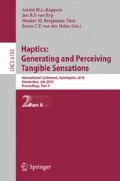Abstract
This study measured the minimum amount of force necessary to identify its direction. The force was produced by a robot and transmitted to a small spherical handle held between the thumb and index finger. We also examined whether this threshold changed during movement. We found that the force threshold was lower when it was possible to move the arm (5 g) than when it was immobile (10 g).
Access this chapter
Tax calculation will be finalised at checkout
Purchases are for personal use only
Preview
Unable to display preview. Download preview PDF.
References
Weber, E.H.: The sense of touch. Academic Press, London (1834/1978)
Baud-Bovy, G., Schochia, L.: Is mass invariant? Effects of movement amplitude and duration. In: Proc. 25th Meeting of the International Society for Psychophysics, Galway, Ireland, pp. 369–374 (2009)
Jones, L.A.: Perception of Force and Weight: Theory and Research. Psychological Bulletin 100(1), 29–42 (1986)
Voerman, V.F., van Egmond, J., Crul, B.J.: Normal values for sensory thresholds in the cervical dermatomes: a critical note on the use of Semmes–Weinstein monofilaments. Am. J. Phys. Med. Rehabil. 78, 24–29 (1999)
Vitello, M.P., Ernst, M.O., Fritschi, M.: An instance of tactile suppression: Active exploration impairs tactile sensitivity for the direction of lateral movement. In: Proc. EuroHaptics 2006, vol. 351, p. 355 (2006)
Brodie, E.E., Ross, H.E.: Jiggling a lifted weight does aid discrimination. The American Journal of Psychology 98, 469–471 (1985)
Zadeh, M.H., Wang, D., Kubica, E.: Perception-based lossy haptic compression considerations for velocity-based interactions. Multimedia Systems 13, 275–282 (2008)
Bocca, F., Baud-Bovy, G.: A model of perception of the central point of elastic force fields. In: 3rd Joint EuroHaptics Conf. and Symp. on Haptic Interfaces for Virtual Environment and Teleoperator Systems, Salt-Lake City, USA, pp. 576–581 (2009)
Olausson, H., Wessberg, J., Kakuda, N.: Tactile directional sensibility: peripheral neural mechanisms in man. Brain Research 866, 178–187 (2000)
Birznieks, I., Jenmalm, P., Goodwin, A.W., Johansson, R.S.: Encoding of Direction of Fingertip Forces by Human Tactile Afferents. Journal of Neuroscience 21(20), 8222–8237 (2001)
Pare, M., Carnahan, H., Smith, A.M.: Magnitude estimation of tangential force applied to the fingerpad. Experimental Brain Research 142, 342–348 (2002)
Jami, L.: Golgi tendon organs in mammalian skeletal muscle: functional properties and central actions. Psychological Review 72(3), 623–666 (1992)
Matthews, P.B.C.: Where does Sherrington’s “Muscular Sense” originate? Muscles, joints, corollary discharges? Annual Review of Neuroscience 5, 189–218 (1982)
Proske, U., Gandevia, S.C.: The kinaesthetic senses. J. Physiol. 587(17), 4139–4146 (2009)
McCloskey, D.I.: Corollary discharges and motor commands. In: Handbook of Physiology The Nervous System III, Motor Control, Bethesda, pp. 1415–1448 (1981)
Author information
Authors and Affiliations
Editor information
Editors and Affiliations
Rights and permissions
Copyright information
© 2010 Springer-Verlag Berlin Heidelberg
About this paper
Cite this paper
Baud-Bovy, G., Gatti, E. (2010). Hand-Held Object Force Direction Identification Thresholds at Rest and during Movement. In: Kappers, A.M.L., van Erp, J.B.F., Bergmann Tiest, W.M., van der Helm, F.C.T. (eds) Haptics: Generating and Perceiving Tangible Sensations. EuroHaptics 2010. Lecture Notes in Computer Science, vol 6192. Springer, Berlin, Heidelberg. https://doi.org/10.1007/978-3-642-14075-4_33
Download citation
DOI: https://doi.org/10.1007/978-3-642-14075-4_33
Publisher Name: Springer, Berlin, Heidelberg
Print ISBN: 978-3-642-14074-7
Online ISBN: 978-3-642-14075-4
eBook Packages: Computer ScienceComputer Science (R0)

